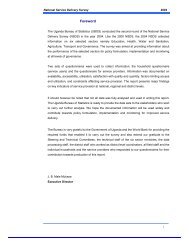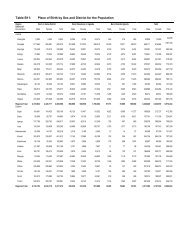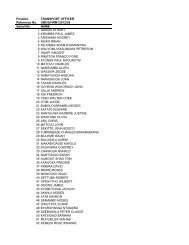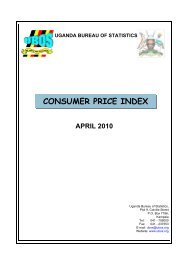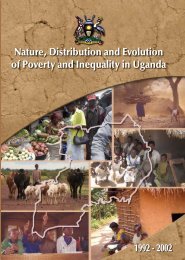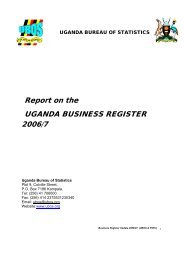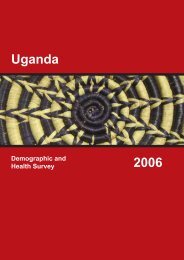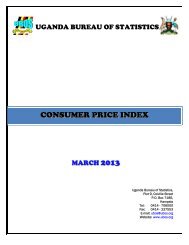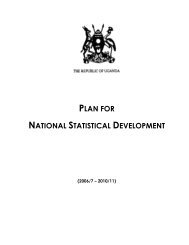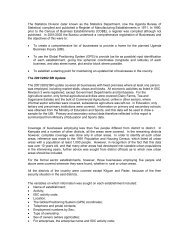Uganda Bureau of Statistics
Uganda Bureau of Statistics
Uganda Bureau of Statistics
You also want an ePaper? Increase the reach of your titles
YUMPU automatically turns print PDFs into web optimized ePapers that Google loves.
Page 8NUTRITIONAL STATUSThe 2000-2001 UDHS looks at several key indicators <strong>of</strong> the nutritional status <strong>of</strong> children, women, and men, including patterns <strong>of</strong>infant feeding practices, anthropometric measurements, prevalence <strong>of</strong> anaemia, vitamin-A deficiency and supplementation, andiodisation <strong>of</strong> salt.Infant feeding practicesBreastfeeding in <strong>Uganda</strong> is almost universal, with 98 percent <strong>of</strong> children having been breastfed atsome time. The proportion is high across all residential areas, and it varies little by subgroups <strong>of</strong> children.In <strong>Uganda</strong>, infant feeding supplementation starts late, which is consistent with World HealthOrganisation (WHO) recommendations. Only one out <strong>of</strong> four children age 2-3 months receives anythingother than breast milk and water-based liquids, and two out <strong>of</strong> three children younger than6 months <strong>of</strong> age are exclusively breastfed.MicronutrientsThe government <strong>of</strong> <strong>Uganda</strong> set a goal <strong>of</strong> reaching 90 percent coverage <strong>of</strong> households having iodisedsalt by the year 2000. To evaluate this program, UDHS interviewers tested salt from each householdfor its iodine content. The tests indicate that the goal has been met and passed, with 95 percent <strong>of</strong>households for which the salt test was performed using adequately iodised salt (15 or more parts permillion).Overall, 58 percent <strong>of</strong> children under 3 years <strong>of</strong> age were reported to have received vitamin-A-richfoods in the 7 days preceding the survey. Consumption <strong>of</strong> vitamin-A-rich foods is highest in the EasternRegion and lowest in the Western Region.Children’s nutritional statusIn the UDHS, two kinds <strong>of</strong> anthropometric measurements were taken for children under 5 years <strong>of</strong> age.They are weight and height (for children age 24 months and older) or recumbent length (for childrenunder 24 months <strong>of</strong> age). Physical growth indices, height-forage,weight-for-height and weight-for-age, are calculated to describechildren’s nutritional status in comparison to a standardschedule developed by the U.S. National Center for Health <strong>Statistics</strong>(NCHS). Children whose height-for-age is more than twostandard deviations below (-2 SD) the median <strong>of</strong> the NCHS referencepopulation are considered short for their age, or “stunted.”Children whose weight-for-age is below (–2 SD) the median <strong>of</strong>the reference population are considered “wasted” or too thinfor their height. Children whose weight-for-age is below(–2SD) the median <strong>of</strong> the reference population are classified as“underweight.”In <strong>Uganda</strong>, four out <strong>of</strong> 10 children below 5 years <strong>of</strong> age arestunted. Stunting is higher among children in the rural areas, inthe Western Region, and among children whose mothers havehad no education. Wasting affects 4 percent <strong>of</strong> children under5 years <strong>of</strong> age. Twenty-three percent <strong>of</strong> children under the age<strong>of</strong> 5 are underweight, which reflects either stunting or wastingor a combination <strong>of</strong> the two. The figures show that there hasbeen little reduction in the levels <strong>of</strong> malnutrition since 1995.S. Poedjastoeti



